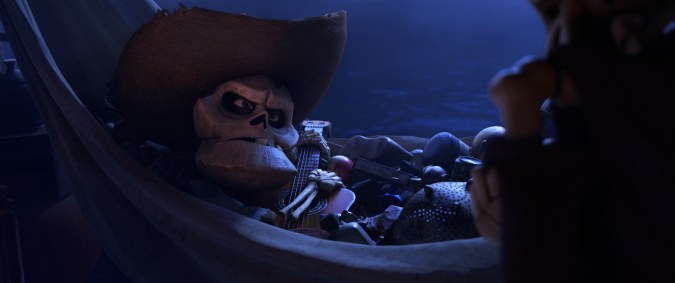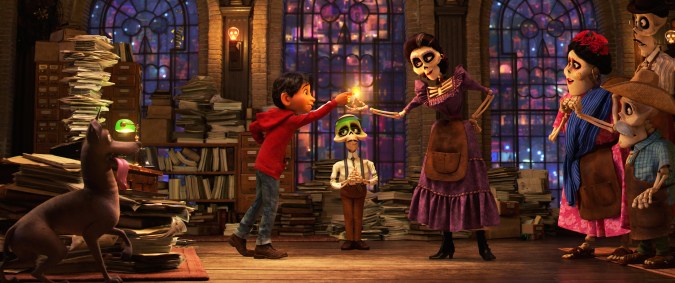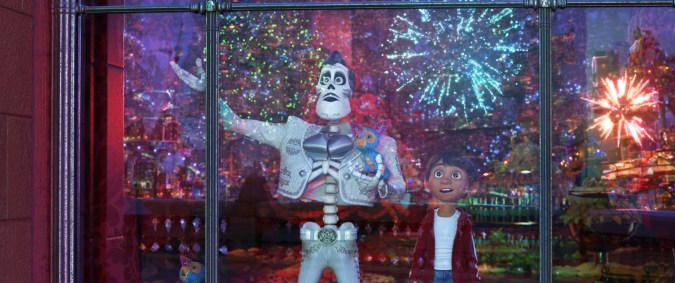Already a cultural phenomenon in Mexico, Pixar’s Coco will likely become the most massively distributed piece of content celebrating a Latin American people ever made. Children and adults across the globe will be presented with a stunning vision of Mexico filtered through the familiar lens of the beloved animated studio. The significance of representation at such a scale is immeasurable.
In addition to breaking box-office records, the animated feature is a cornerstone in Mexicans’ reassessment of our own culture. Día de Muertos is on its way to becoming as ubiquitous as Halloween, an American holiday Mexicans once feared would replace the mystical indigenous celebration of the afterlife. A renewed sense of pride has been instilled in the country since productions like James Bond’s latest adventure Spectre and now Coco have paid attention. Though it shouldn’t had taken external validation for us to appreciate what was always there, that foreign perspective seems to have nudged our general consciousness towards a positive outlook on who we are.
Digging beyond superficial conventions, Pixar found the heart of Coco in specificity. The smallest details like seeing pan dulce, a Mexican soccer jersey, or papel picado on screen are some of the most palpable examples of how in depth their research and attention to seemingly minuscule elements was. Unlike Disney’s culturally ambiguous attempt at depicting Latin America in The Emperor’s New Groove, Coco, co-directed by Mexican-American screenwriter Adrian Molina and infused with the help of advisors from the Latino community, shines because of those subtle touches that might be imperceptible for most, but essential for Mexicans.
Pixar’s rigorous penchant for authenticity is also present in the voice cast with an all-Latino ensemble in the English version and Mexican actors for the Spanish dub. Remezcla sat down with Gael García Bernal, who voices Héctor in both languages; Edward James Olmos, whose character Chicharrón is small but crucial; and Benjamin Bratt, who sings as Ernesto de la Cruz. Our colorful conversations ranged from the importance of people of color on the screen to whom they’d like to hang out with in the afterlife.
On Who They Would Hang Out or Party With In the Land of the Dead
Gael García Bernal: I’d love to cotorrear with John Lennon and I’d love to have a conversation with Sor Juana Inés de la Cruz. With her I’d love to spend three entire days walking and camping. I’d love to go camping with Sor Juans Inés de la Cruz. I’d love to know what the hell did she think about life. Recently I’ve been fascinated by her because of her intelligence and the complexity of what she wrote.
Benjamin Bratt: I want to say Martin Luther King Jr., because for someone as reverential as he was, I bet he got down. He was certainly a passionate man. Who else? My goodness, it’s a great question. I would love to hang out with Bruce Lee. Talk about a magnetic star, and someone whose life ended far too soon, at 32. He was a deeply philosophical man, with tremendous wisdom and insight for someone so young. Now in hindsight, you realize he was quite a young man. I would have loved to decrypt his notes, to find out what made him tick, and perhaps even take a lesson from him.
Edward James Olmos: God, I never thought about that one. I think it would be my great-grandpa. He was probably one of my biggest influences. He died when I was around seven. He raised me – my great-grandmother and my great-grandfather. They were the ones who were home. My grandparents were working, and my parents were working, so they took care of us. Boy, it was a whole different experience being brought up by a great-grandparent than by a grandparent or a parent. I was very grateful. A lot of wisdom, you get wisdom in a very different way. You don’t realize it until you get older as to what your influences were, and what happened to you. I’m very grateful.

Edward James Olmos on How His Youth Cinema Project Is the Future of Animation
Our children go to Pixar. They’re allowed to come in. They go in there, and they experience the whole Pixar studio. We’re the only group that goes into the studio, so our children are exposed to it, those whose who live up north. Here, they go to Disney, and they experience that studio and that situation. I pray that this is so successful, and I think it’s going to be. I think it might capture the heart and the imagination of all of the country, not just Latinos, but just with Latinos alone, it’ll become the biggest, most successful Pixar movie they’ve ever had.
Gael García Bernal On Voicing Hector in English and Spanish
In English that’s the original version and that’s the one where we rehearsed and play a lot with what we were doing. That’s where we were able to find the character. In Spanish there was very little time to do it and there is also a way of doing things that’s very delimitated about how it’s being dubbed. That version is actual dubbing. In English it’s not dubbing in fact, it’s a recording. It’s a collaborative creation. Also, in the English version there is a lot of Spanglish. The Spanish version is all in Spanish, and the story is supposed to actually take place in Spanish because it’s in Mexico, so it’s a strange game, but it’s part of the cocktail of making movie.
On Why Representation in Film Matters
Edward James Olmos: This is the reason why this is the single most powerful and most riveting art form in the world; more than a live performance, more than a book, or a painting, or music. You can’t compare. This attacks the subconscious mind. It goes right inside, and it stays there, it doesn’t go away. That’s why people don’t want to see Jaws or Psycho, or movies that will give you nightmares later on, because you can’t get it out, it’s in there, it’s forever. So that’s why this is so important.
Benjamin Bratt: I think there’s no avoiding the fact that, as a people that are descended from colonized people, this part of the culture that has both European history and indigenous history, and that’s reflected in some of the iconography we see, the presence of Aztec ruins and pyramids in the land of the dead. As descendents of that particular group of people, somehow we have subconsciously been inoculated with this idea of oppression, and not necessarily always recognizing our self worth. When you’re told over and over again for centuries that you’re not equal, you’re not human, we don’t value your language, we don’t value your spiritual traditions, we don’t value your humanness, you can’t on some level absorb that teaching, and it becomes a kind of sickness for the soul, so to be able to see an image of yourself projected on a large screen like that, that actually celebrates who you are, and celebrates your origins, and celebrates those traditions and religious beliefs, and ways of operating and dealing with your family, and this notion of family first, not only is it timely, but also it’s quite special.
Gael García Bernal: I loved the trans-cultural exercise that Pixar did. This is not something minor, seriously. Pixar was able to make a great Mexican film. Everyone in Mexico is watching this movie and saying, “Cabrón, this is like if we had done it ourselves.” It feels like it was made in Mexico. We shouldn’t minimize that because this speaks of a cinematic triumph and the triumph of otherness, migration, foreignness, the coming and going, and cultural interdependence. Cultural interaction is the best bridge to reach a better future for humanity. It’s about what Mexico provides plus the point of view of the foreigner about the same thing. It’s a glorious mix. I’m very proud of the final product. It’s really a great movie.

Benjamin Bratt on Coco and Dolores Sharing a Cultural DNA
Dolores is a project that began five years ago. That it comes in this particular time of divisive rhetoric is, I think, a kind of Godsend. Similarly, there’s far less political point of view when it comes to the film Coco, and yet the messaging is very similar. They share a kind of cultural DNA, in that both films go a long way in what they are trying to say, which is that Latinos are here, we have been here, we are as much an important part of the American fabric as any other person wherever they come from, and we always have been. In fact, the particulars of our culture, whether it’s artistic expression, or language, or religious beliefs, or the connectivity of family, or the importance of maintaining that as the center of our universe, are qualities that are shared by most human beings around the world, so at the end of the day, we’re all the same. Both films really go a long way in saying that we deserve an equal stance. Our stories and our identities are as important as anyone else’s because they are equal to everyone else’s.
Gael García Bernal on the Power of Animation
There is not a notion of how the Land of the Dead looks. It’s such an open and generous celebration that nobody has the certainty of how it is. That’s part of the beauty of the Día de Muertos celebration, that there is not a single truth about what happens after death. We all have our own point of view. Here, they created a world around what the Land of the Dead is. In Ratatouille, for example, what’s fascinating is that they manage to create a climax with a flashback to a childhood. That hasn’t been achieved and can’t be achieved by a live-action movie because since they are drawings we become more permissive and we allow our imagination to fly. What happens with animation is that our imagination is working constantly, as opposed to when we watch something grounded on real life. Animation is like a book. We fill in the blank spaces. Whatever the animators didn’t animate, we animate it with our imagination.
On Working Only With Their Voices
Benjamin Brat: The first thing an actor does to discover a way to create a character on film is to read the lines, but we also rely on our bodies and our facial expressions. That’s different when you’re limited to only using your voice, so Adrian Molina and Lee Unkrich pointed me in that very specific direction of, “Please go study the films of Pedro Infante and Jorge Negrete, in particular because those guys were just like Ernesto de la Cruz, in that they were as beloved and as famous for their singing abilities as they were for their acting chops, and the star-making turns they had in Mexican cinema. True movie stars, people with natural magnetism and larger than life personas, and this is the character that you need to capture. That, for me, was the fun, and then beyond that, the opportunity to sing. I’m an actor, I’m not a singer at all, so that was quite a bit terrifying to have to attempt it, but I also love a challenge, so I was up for it.
Edward James Olmos: The process is uniquely its own. It’s an entirely different type of experience, both for the artist and for the situation with how you’re represented, because it’s just the tone of your voice, so you kind of lock out everything else. You might act it out, but you’re really focused on the way that your voice is being used. When you’re on camera, it’s a mixture of things: everything that you’re doing facially, and with your hands, and the way you hold yourself, it all says something. Here, it’s strictly your voice.
Gael García Bernal: The idea of not having the physicality is really crazy at the beginning because you are, “How do they do it? Does you speak and then they animated you? What’s the order of things?” You rehearse, you play, you construct the character, and then they animated over that. It’s a very particular, original, and rigorous process that Pixar has. And I think that’s why their movies come out so great. They are really good movies. They are fascinating. I think Coco and Ratatouille are two of my top favorite movies in the world of animation.

Benjamin Bratt on the Importance of Latino Stories in the Mainstream
When I walked into a room that held all of the imagery that they were going to present within the film, everything from real photographs from their trips to Oaxaca and different pueblos in Mexico, to Dia de Muertos iconography that was pinned to the wall, to color renderings of the what the characters were going to look like, I was moved because in that moment, I recognized that at long last, a representation of who we are as a people would reach a global audience through the storytelling of a company like Pixar. And that’s not a small thing, because we are the stories that we tell about ourselves.
Gael García Bernal on the Cultural Hive Reflected in Coco
The movie reflects the fact that there is a cultural hive all the guys and girls that were born or were raised in the United States and that are the children, grandchildren, or great-grandchildren of Mexicans or Latin Americans have. They have a cultural hive to go back to. I hope that hive gives them the strength to counter the lies that are being said about them in the United States. I feel it’s important to have these arguments and for them to know that there is even a celebration or a tradition that is much more complex, much more profound, and much more sophisticated that any tradition that could exist here. That’s so damn important cabrón.




